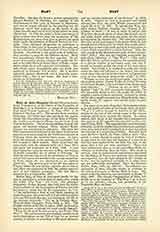

Martyrs, THE TEN THOUSAND.—On two days is a group of ten thousand martyrs mentioned in the Roman Martyrology. On March 18: “At Nicomedia ten thousand holy martyrs who were put to the sword for the confession of Christ”, and on June 22: On Mount Ararat the martyrdom of ten thousand holy martyrs who were crucified.” The first entry, found in an old Greek martyrology, translated by Cardinal Sirleto and published by H. Canisius, probably notes the veneration of a number of those who gave their lives for Christ at the beginning of the persecution of Diocletian, in 303 (Acta SS., March, II, 616). That the number is not an exaggeration is evident from Eusebius (“Hist. Eccl.”, VIII, vi), and Lactantius (“De morte persecut.”, xv). The entry of June 22 is based upon a legend (Acta SS., June, V, 151) said to have been translated from a Greek original (which cannot, however, be found) by Anastasius Bibliothecarius (who died in 886), and dedicated to Peter, Bishop of Sabina (? d. 1221). The legend reads: The emperors Adrian and Antoninus marched at the head of a large army to suppress the revolt of the Gadarenes and the people of the Euphrates region. Finding too strong an opponent, all fled except nine thousand soldiers. After these had been converted to Christ by the voice of an angel they turned upon the enemy and completely routed them. They were then brought to the top of Mount Ararat and instructed in the faith. When the emperors heard of the victory they sent for the converts to join in sacrifices of thanksgiving to the gods. They refused, and the emperors applied to five tributary kings for aid against the rebels. The kings responded to the call, bringing an immense army. The Christians were asked to deny their faith, and, on refusal, were stoned. But the stones rebounded against the assailants, and at this miracle a thousand soldiers joined the confessors. Hereupon the emperors ordered all to be crucified. The Spanish version of the legend makes the martyrs Spaniards converted by St. Hermolaus, a supposed Bishop of Toledo. Many difficulties are created by the legend, it contains so many historical inaccuracies and utterly improbable details. The martyrs are not given by anyone before Petrus de Natalibus, Bishop of Equilio in 1371. The Greeks do not mention them in the Menaea, Menologium, or Horologium, nor do the Copts or Armenians. Surius omitted them in the first and second editions of his “Vitae Sanctorum”. Henschenius the Bollandist intended to put the group among the Praetermissi. Papebroeck admitted it to the body of the work only on the authority of Radulph de Rivo (Bibl. Patrum, XXVI, Lyons, 1677, 298) and classifies the Acts as apocryphal, while Baronius takes up their defense (Annales Eccl., ad an. 108, n. 2). The veneration of the Ten Thousand Martyrs is found in Denmark, Sweden, Poland, France, Spain, and Portugal. Relics are claimed by the church of St. Vitus in Prague, by Vienne, Scutari in Sicily, Cuenca in Spain, Lisbon and Coimbra in Portugal.
FRANCIS MERSHMAN

